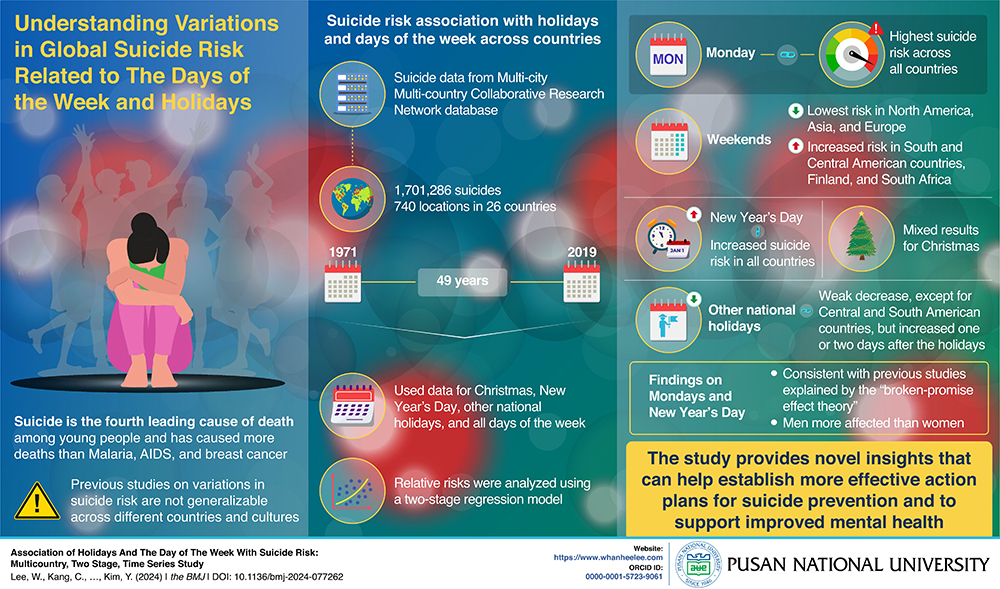- 작성일
- 2024.11.11
- 수정일
- 2024.11.11
- 작성자
- 이현경
- 조회수
- 245
[이환희 교수팀] 26개국 170만여 건 자료 분석…요일·공휴일 자살 위험 패턴 규명

우리나라를 포함해 세계 공통적으로 월요일과 새해 첫날에 자살 위험이 가장 높다는 부산대 연구 결과가 나왔다. 자살 예방을 위한 효과적인 맞춤형 행동 계획 수립에 도움을 줄 전망이다.
정보의생명공학대학 의생명융합공학부 이환희 교수 연구팀이 요일·공휴일별 자살 위험 패턴과 관련해 한국·일본 등 26개국의 1971년부터 2019년까지 49년간 170만여 건의 자료를 바탕으로, 모든 국가에서 월요일 자살 위험이 가장 높고 새해 첫날 또한 자살 위험이 증가한다는 분석 결과를 얻었다.
※ 분석 대상 26개국: 캐나다, 미국, 코스타리카, 과테말라, 멕시코, 브라질, 칠레, 에콰도르, 파라과이, 오스트레일리아, 남아프리카, 중국, 일본, 한국, 필리핀, 대만, 베트남, 체코, 에스토니아, 핀란드, 독일, 이탈리아, 루마니아, 스페인, 스위스, 영국
자살은 전 세계적으로 주요한 공중 보건 문제로, 특히 15세에서 29세 사이의 젊은 층에서는 네 번째로 높은 사망 원인이다. 자살의 시간적 변동을 이해하는 것은 이러한 심각한 문제에 대응하고, 효과적인 예방 전략을 마련하는 데 필수적인 요소다.
그동안 자살 위험의 시간적 변동을 다룬 연구들이 있었지만, 대부분 서구권에 편중돼 그 결과를 다양한 문화권에 적용하는 데 한계가 보였다. 특히, 아시아를 포함한 서구권 이외의 국가들을 대상으로 한 포괄적인 연구는 매우 부족한 실정이었다. 이러한 공백을 해소하기 위해 부산대 연구팀은 한국과 일본을 포함한 여러 국가의 데이터를 바탕으로 요일 및 국가 공휴일에 따른 자살 위험 변동 연구를 수행했다.
이를 위해 이환희 교수팀은 26개국 740개 지역에서 수집된 데이터를 활용해 자살 위험 패턴을 조사했다. 연구는 다국가 다도시 협력 연구 네트워크(Multi-City multi-Country, MCC)의 데이터베이스를 기반으로 1971년부터 2019년까지의 일별 자살 건수와 일평균 기온 데이터를 포함한 170만 건 이상의 자살 사례 분석으로 진행됐다.
연구 결과, 모든 국가에서 월요일에 자살 위험이 가장 높았다. 이러한 결과는 ‘깨진 약속 효과(Broken Promise Effect)*’가 가장 유력한 가설로 설명될 수 있으며, 사람들이 새로운 주기가 시작될 때 절망감이 커져 자살 위험이 급격히 상승할 수 있다는 것이다. 반면, 주말의 영향은 국가마다 다르게 나타났다.
* 깨진 약속 효과(Broken Promise Effect): 사람들이 주말이나 연말처럼 한 주기가 끝날 때 새로운 시작을 기대하며 자살을 미루다가, 월요일이나 새해 첫날처럼 새로운 주기가 시작되면 더 큰 절망감을 느끼며 자살 위험이 증가하는 현상.
새해 첫날에도 모든 국가에서 자살 위험이 크게 증가하는 경향이 나타났다. 크리스마스의 경우 국가마다 자살 위험의 패턴에 차이가 있었으며, 많은 국가에서 공휴일 이후 자살 위험이 상승하는 경향을 보였다.
또한, 남성이 여성보다 월요일과 새해 첫날 같은 특정 시점에 자살 위험이 더 크게 증가하는 것으로 나타났으며, 이는 성별에 따른 자살 예방 전략의 필요성을 시사한다.
월요일과 새해 첫날에 자살 위험이 가장 높다는 분석 결과는 자살 예방 전략 수립 시 특정 요일과 시기에 맞춤형 개입의 필요성을 제시한다. 이번 연구는 자살 위험이 시간적·문화적 요인에 따라 달라질 수 있다는 중요한 통찰을 제공하며, 각국이 자살 위험이 높은 시기에 효과적이고 시기적절한 대응책을 마련하는 데 기여할 것으로 기대된다.

【이환희 교수】
이번 연구는 부산대 의생명융합공학부 이환희 교수, 서울대 보건대학원 강신우 박사과정생, 일본 도쿄대 글로벌환경보건학과 김윤희 교수가 주도해 다국가 다도시 협력 연구 네트워크(MCC)로 구성된 국제 연구팀과 함께 공동으로 진행했다.
해당 연구결과는 세계적인 국제 학술지 『The BMJ(British Medical Journal)』 10월 23일자에 게재됐다.
- 논문 제목: Association of holidays and the day of the week with suicide risk: multicountry, two stage, time series study (공휴일 및 요일과 자살 위험의 연관성: 다국가, 2단계, 시계열 연구)
- 논문 링크: https://www.bmj.com/content/387/bmj-2024-077262.full
연구를 주도한 이환희 교수는 “이번 연구는 다양한 국가에 통합된 접근 방식을 적용함으로써, 요일 및 휴일에 따른 자살 위험이 공간적·문화적 요인에 따라 어떻게 변하는지를 심층적으로 이해할 수 있는 중요한 자료를 제공한다”며 “이를 바탕으로 근거 기반의 자살 예방 이론이 더욱 강화되고, 효과적인 자살 예방 전략이 마련되는 계기가 되길 바란다”고 말했다.
* 상단 그림: 요일 및 공휴일에 따른 자살 위험 변화
이번 연구는 월요일과 새해 첫날에 자살 위험이 가장 높다는 사실을 여러 국가에서 밝혀냈다. 이러한 발견은 자살 예방을 위한 더 효과적이고 맞춤형 행동 계획 수립에 기여할 수 있다.
[Abstract]
Pusan National University Researcher Unveil That Mondays and New Year’s Day Have Highest Suicide Risk
Researchers investigated temporal variations in suicide risk across multiple countries, revealing crucial insights for improved prevention strategies
Suicide, a leading global health concern, ranks fourth among young people. Although many studies have reported temporal variations in suicide risk, most are limited to Western countries. Addressing this gap, researchers from Korea and Japan in collaboration with other countries conducted a multi-country multi-city study to investigate variations in suicide risk based on the day of the week and national holidays, revealing key insights that could help form effective and targeted suicide prevention action plans.
Suicide is a pressing global public health concern, claiming around 700,000 lives in 2019 according to the World Health Organization, making it the fourth leading cause of death among young people aged between 15 and 29 years. Understanding the mechanisms of suicide is, therefore, essential for creating effective prevention strategies.
Research has shown that suicide rates vary with the time of the year. Several studies have also reported short-term variations based on the day of the week and holidays. The “broken-promise effect theory” has been widely adapted to explain these variations. This theory states that people may postpone suicides in hopes of a new beginning when a cycle ends, such as on weekends or at the end of the year, while they may feel more vulnerable and hopeless at the start of a new cycle, such as on Mondays or New Year’s Day. However, these findings cannot be generalized, as existing studies mainly focus on Western countries.
To address this gap, an international research team consisting of Whanhee Lee (Assistant Professor, the School of Biomedical Convergence Engineering at Pusan National University, South Korea), Cinoo Kang (Doctoral Student, the Graduate School of Public Health, Seoul National University, South Korea), Yoonhee Kim (Associate Professor, Department of Global Environmental Health, The University of Tokyo, Japan), and the Multi-City multi-Country (MCC) Collaborative Research Network investigated short-term variations in suicide risk concerning the days of the week and national holidays across various countries.
“Applying a unified approach to various countries allows us to provide comparable results and better understand how suicide risk changes across different timescales and diverse cultures,” explains Dr. Lee. Their study was published in The BMJ on date month, year.
The researchers used an advanced statistical technique called standardized two-stage time series analysis to investigate suicide risk patterns. They analyzed data from 740 locations across 26 countries, gathered from the Multi-country Multi-city Collaborative Research Network database. This dataset comprised 1.7 million suicide cases, including daily suicide counts along with daily mean temperature data spanning from January 1971 to December 2019.
The results revealed that suicide risk was highest on Mondays across all countries, though the effect of weekends varied. New Year’s Day was associated with an increase in suicide risk in all countries, while Christmas showed a mixed pattern. Although there was an overall decreasing trend in suicide risk on other national holidays, the risk tended to increase after these holidays in most countries. Notably, the findings also showed that men are more vulnerable to variations related to the day of the week and New Year’s Day compared to women.
Highlighting the importance of this study, Dr. Lee remarks “Our findings provide a better understanding of the temporal variations in suicide, which can lead to better evidence based-suicide theories.”
We hope that this large-scare study can lead to timely interventions, potentially saving countless lives.
* Reference
- 1st author (Pusan National University): Whanhee Lee (School of Biomedical Convergence Engineering)
- Title of original paper: Association of holidays and the day of the week with suicide risk: multicountry, two stage, time series study
- https://www.bmj.com/content/387/bmj-2024-077262.full
- Journal: The BMJ
- DOI: 10.1136/bmj-2024-077262
- About the author
Dr. Whanhee Lee is an Assistant Professor at the School of Biomedical Convergence Engineering at Pusan National University. He has a Ph.D. in Public Health (Biostatistics major) from Seoul National University and his main research interests include climate change, air pollution, health disparities, and planetary health. He can be reached at whanhee.lee@pusan.ac.kr.
- Lab website: https://www.whanheelee.com
- ORCID id: 0000-0001-5723-9061
- 첨부파일
- 첨부파일이(가) 없습니다.
- 다음글
-
[서민호 교수 연구팀] 장시간 지속 가능한 무선 수소 감지 센서 개발이현경 2024-12-11 10:57:42.98
- 이전글
-
2024 MICCAI 주최 3차원 초음파 영상 챌린지(국제 대회) 수상이현경 2024-10-25 13:56:09.663
